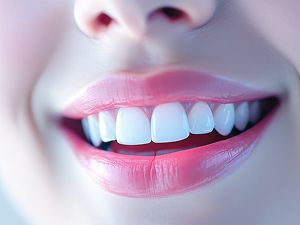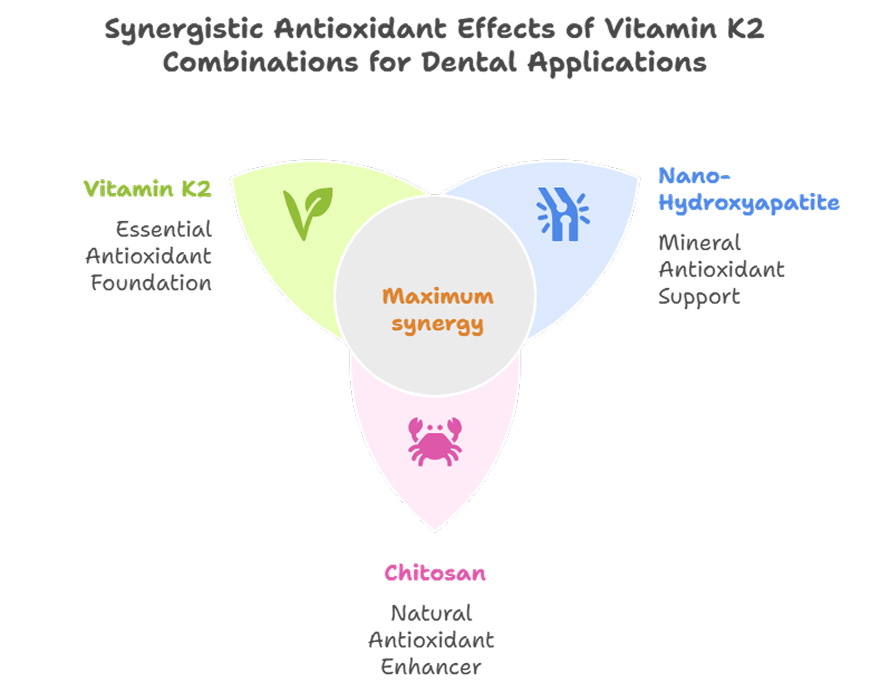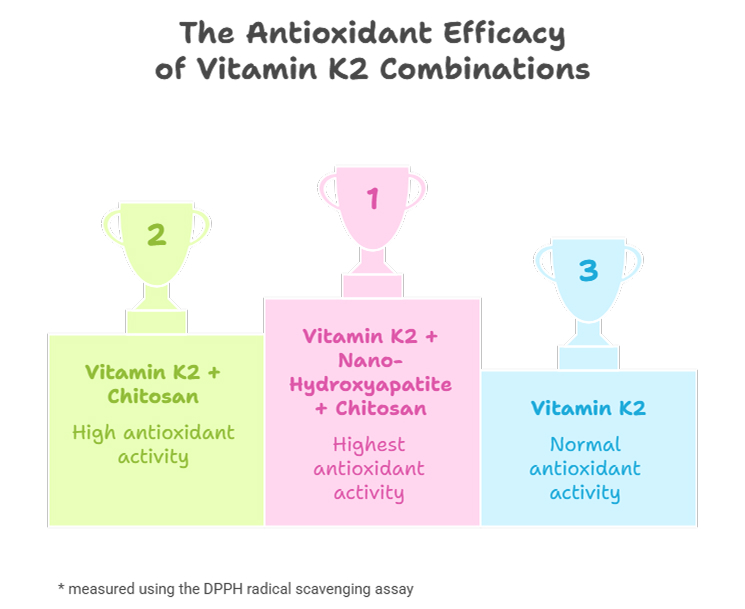dental

Nanocomposites with Antioxidant Properties for Dental Applications
Nanocomposites with antioxidant properties are gaining increasing importance in biomedical and particularly dental research. These materials combine conventional substances with nano-particles, aiming to enhance mechanical, chemical, or biological performance. [1]
Benefits for Oral Health
Cell damage and oxidative stress – caused by socalled free radicals – also affect the oral cavity. Antioxidants help neutralize these harmful molecules and thus play a vital role in maintaining dental health.
One particularly promising compound is vitamin K2, which has anti-inflammatory properties and supports bone metabolism [2]. This contributes to the prevention of osteoporosis and tooth loss. In addition, there is evidence suggesting that vitamin K2 may help prevent or even reduce vascular calcification, which can have a positive impact on overall oral health. [3]
Recent studies further indicate that vitamin K2 may influence inflammatory processes in the gums. It may help regulate immune responses and reduce inflammation in the oral cavity through specific mechanisms. [2]
Research on Antioxidant Nanocomposites
A recent study examined the antioxidant effects of nanocomposites composed of hydroxyapatite, chitosan, and vitamin K2. Four different solutions were tested (Vitamin K2, Vitamin K2 combined with chitosan, Vitamin K2 combined with nano-hydroxyapatite and Vitamin K2 with both chitosan and nano-hydroxyapatite as a complete nanocomposite).
The antioxidant activity was measured using the DPPH radical scavenging assay, a wellestablished method for quantifying free radical activity. The results showed that the combination of vitamin K2, chitosan, and nano-hydroxyapatite demonstrated the highest antioxidant activity, followed by the variant with vitamin K2 and chitosan. [1]
Potential for Dental Applications
Due to their high antioxidant capacity, such nanocomposites are considered promising candidates for a variety of dental applications [4]. Potential uses include:
• Protective coatings for filling materials to reduce oxidative damage
• Implant coatings to support tissue healing
• Innovative oral care products designed to neutralize free radicals and promote oral health [5]
The findings suggest that nanocomposites combining vitamin K2, chitosan, and nano-hydroxyapatite offer an effective way to enhance dental materials. Further research is needed to identify the optimal formulation and application of these innovative materials. [1]
You can find a wide selection of chitosan products suitable for dental applications in our online shop. Feel free to contact us – we’ll be happy to help you find the perfect candidate for your project!
Beyond Antioxidants: Promising Antimicrobial Effects
In addition to their antioxidant properties, nanocomposites composed of vitamin K2, chitosan, and nano-hydroxyapatite have also demonstrated promising antimicrobial activity. Recent studies revealed that these materials significantly inhibit the growth of clinically relevant microbial strains. When used as a coating for dental implants, they offer a dual benefit: protection against oxidative stress and effective defense against bacterial colonization—both critical factors for longterm osseointegration and the preservation of periimplant tissue health. [6]
Summary:
A newly developed nanocomposite made from vitamin K2, chitosan, and nano-hydroxyapatite shows significant antioxidant and antimicrobial properties in vitro. Chitosan, in particular, plays a major role in the bioactive functionality of the material.
Key Findings:
• Highest antioxidant activity observed with the combination of vitamin K2 + chitosan + nano-hydroxyapatite
• Significant inhibition of microbial strains relevant to oral health
• Chitosan acts synergistically and additionally supports osseointegration in implants
• Suitable for dental applications such as implant coatings, filling protection, and bioactive oral care
References
1. Free radical scavenging activity of nano-hydroxyapatite (HA)/chitosan/vitamin K2 for biomedical applications | AIP Conference Proceedings | AIP Publishing, accessed 06.06.2025
2. Vitamin K2 as an Anti-Inflammatory Agent? – Biochemistry for Your Genetic Potential, accessed 10.06.2025
3. Torhaus – Your Dentists | Why Are K Vitamins Important for Dental Health?, accessed 10.06.2025
4. A Review on Nanocomposite Coatings in Dentistry | Journal of Materials Science, accessed 06.06.2025
5. Use of Antimicrobial Nanoparticles for the Management of Dental Diseases, accessed 06.06.2025
6. Assessment of Antimicrobial Activity of Nanocomposites Based on Nano-Hydroxyapatite (HAP), Chitosan, and Vitamin K2

3D bio-printed chitosan networks for dental applications
Dental, bacterial diseases such as periodontitis can lead to tooth and bone loss. In the study presented here, chitosan, gelatine and Scutellariae baicalensis radix were combined to form a hydrogel to produce an anti-inflammatory implant using 3D bioprinting.

Publications in June 2017 - Chitosan-based coatings for dental implants
The development of a strong bond between implant surface and the surrounding bone substance, called osseointegration is important for successful integration of a dental implant. The coating of dental implants with chitosan is a promising approach to enable an accelerated and improved integration. In the following, we present two publications about chitosan-based coatings for dental implants.

Publications in May 2015
166 articles about chitosan were published in May 2015. In the rank of nations scientists from China gained with 39 publications the leading position, followed by India (16), the US (12) and Italy (11). The research priorities focused on nanoparticles, evaluation studies and pharmaceutical preparations.

Publications in July 2011
After dropping in the previous months, the publication number of chitosan articles slightly increased in July. Overall 76 articles were published in this field. In July 2010 83 articles were published, in comparison to this year it is only a small difference.





